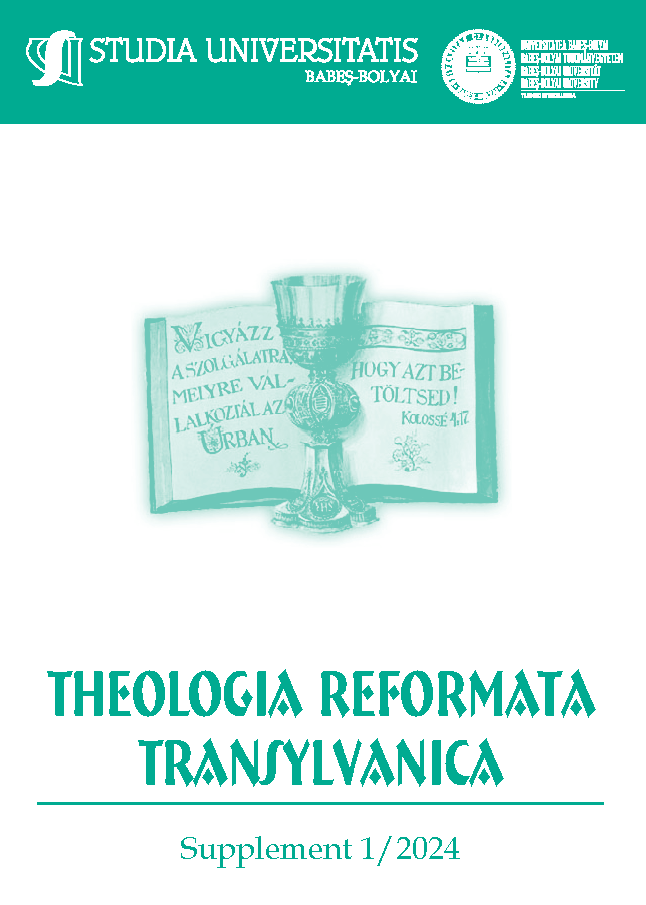Changes in the Language of the Reformed Church in the Second Half of the 20ᵗʰ Century: The Convergence of Oral History and Big Data
DOI:
https://doi.org/10.24193/subbtref.69.suppl1.12Keywords:
: language of the church, Bible translation, vocabulary of the Bible, , letter and soul, protestant language useAbstract
The author’s journey begins with a deep immersion in his traditional Protestant faith, where he was taught to thoroughly know both the Old and the New Testament. As he reflects on his faith, the concept of being a “stranger and sojourner” comes to the forefront, highlighting the feeling of alienation within the secular world.
The narrative takes an interesting turn when the author discusses the impact of changing political language on his perspective. The introduction of new political ideas and discourse challenges the previously straightforward worldview, leading to a sense of uncertainty in decision-making. Believers find themselves in a world with a multiplicity of perspectives that require a re-evaluation of what it means to “deny” or to make choices.
In a changing social and political context, the narrative continually explores the intricate connection between faith and language. The author’s experiences and reflections provide a compelling insight into the complexities of navigating a shifting spiritual landscape while grappling with the ever-evolving meaning of words and beliefs.
The second half of the article presents the results of a computer analysis of the vocabulary of two Bible translations that defined the language usage of the Reformed Church in the second half of the 20th century: the 1908 Károli and the 1975 New Translation. The analysis focuses on words that present difficulties in understanding due to their archaic or religious nature. As a point of comparison, it also showcases the vocabulary of the Gospel of John, where a mere 199 word roots constitute 80% of word occurrences.
References
BANCZEROWSKI, Janusz (2008): A világ nyelvi képe. A világkép mint a valóság metaképe a nyelvben és a nyelvhasználatban. Budapest, Tinta.
BARANYI, József (1995): Konkordancia a Károli Bibliához. Budapest, Veritas.
CHAPP, Ch. B. (2012): Religious Rhetoric and American Politics: The Endurance of Civil Religion in Electoral Campaigns. Ithaca, Cornell University Press.
DÁVIDHÁZI, Péter (2017): “Jövevények és zsellérek”. Egy bibliai fogalompár nyomában. In: Dávidházi, Péter: „Vagy jőni fog”. Bibliai minták nemzetiesítése a magyar költészetben. Budapest, Ráció. 15–36.
ESTERHÁZY, Péter (2000): Harmonia Caelestis. Budapest, Magvető. English translation (2004): Celestial harmonies. Tranl. by Judith Sollosy. New York, Ecco. 74.
(2002): Javított kiadás. Budapest, Magvető.
GADAMER, Hans-Georg (1984): Igazság és módszer: Egy filozófiai hermeneutika vázlata. Budapest, Gondolat Kiadó. English translation (2004): Truth and Method. Translation revised by Joel Weinsheimer and Donald G. Marshall. London, Continuum.
HABERMAS, Jürgen (2006): Religion in the Public Sphere. In: European Journal of Philosophy. 14, 1. DOI: 10.1111/j.1468-0378.2006.00241.x.
HANULA, Gergely (2016): Anyaszentnyelvünk. A „szent nyelvek” és a fordítás. Budapest, Argumentum.
KOSZTOLÁNYI, Dezső (1999): Lélek és nyelv. In: Kosztolányi, Dezső: Nyelv és lélek. Budapest, Osiris.
MÉSZÖLY, Miklós (1977): Biblia – bibliák. In: Mészöly, Miklós: A pille magánya. Budapest, Szépirodalmi Könyvkiadó.
PIER, Penni M. (2010): Deities, Divisions, and Democrats. The “Political Left” and Religion. In: Weiss, David (ed.): What Democrats Talk about When They Talk about God. Religious Communication in Democratic Party Politics. Lanham, Lexington.
RAPPAPORT, Roy A. (1999): Ritual and Religion in the Making of Humanity. (Cambridge Studies in Social and Cultural Anthropology 110). Cambridge, Cambridge University Press.
ZSIBRITA, János – VINCZE, Veronika – FARKAS, Richárd (2013): magyarlanc. A Toolkit for Morphological and Dependency Parsing of Hungarian. In: Proceedings of RANLP, Sumen, INCOMA. 763–771.
Downloads
Published
How to Cite
Issue
Section
License
Copyright (c) 2024 Studia Universitatis Babeș-Bolyai Theologia Reformata Transylvanica

This work is licensed under a Creative Commons Attribution-NonCommercial-NoDerivatives 4.0 International License.






